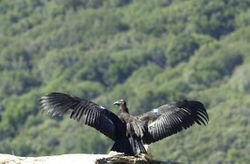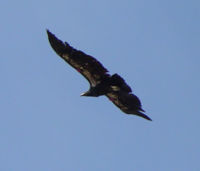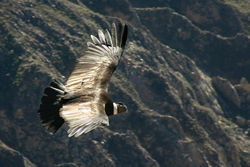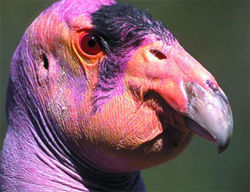|
Condors |

Immature California Condor
|
|
Scientific classification |
| Kingdom: |
Animalia
|
| Phylum: |
Chordata
|
| Class: |
Aves
|
| Order: |
Ciconiiformes
|
| Family: |
New_World_vulture.html
|
|
| Genera |
Vultur
Gymnogyps |
Condor is the name for the largest
species of
New World vultures. They are the largest flying land
birds in the
Western Hemisphere.
There are two species, each in its own
monotypic
genus:
- The
Andean Condor (Vultur gryphus) which
inhabits the
Andes mountains.
- The
California Condor (Gymnogyps californianus)
nowadays restricted to western coastal mountains of the
United States.
Taxonomy
Although they are primarily scavengers, feeding on
carrion, these species belong to the New World vulture
family Cathartidae, most likely closer related to the
storks instead of
Old World vultures. The latter are in the diurnal raptor
family
Accipitridae along with
hawks,
eagles and
kites.

California Condor in high speed flight - note
tip feathers faired to reduce drag.
Appearance
Both condors are very large broad-winged soaring birds,
the Andean Condor being 5 cm shorter (beak to tail) on
average than the northern species, but larger in wingspan.
Measurements are usually taken from specimens reared in
captivity.

An Andean Condor soars over southern
Peru's Colca Canyon
The adult
plumage is of a uniform black, with the exception of a
frill of white feathers nearly surrounding the base of the
neck and, especially in the male, large patches or bands of
white on the wings which do not appear until the completion
of the first moulting. As an adaptation for hygiene, the
head and neck have few feathers (see below photo), exposing
the skin to the sterilizing effects of dehydration and
ultraviolet light at high altitudes, and are meticulously
kept clean by the bird. The head is much flattened above. In
the male it is crowned with a caruncle or comb, while the
skin of the neck in the male lies in folds, forming a
wattle. The skin of the head and neck is capable of flushing
noticeably in response to emotional state, which serves to
communicate between individuals.
The middle toe is greatly elongated, and the hinder one
but slightly developed, while the talons of all the toes are
comparatively straight and blunt. The feet are thus more
adapted to walking as in their relatives the storks, and of
little use as weapons or organs of prehension as in birds of
prey and Old World vultures. The female, contrary to the
usual rule among
birds of prey, is smaller than the male.

California Condor's head (adult)
Behavior
Sexual maturity and breeding behavior do not appear in
the condor until 5 or 6 years of age. They may live for 50
years or more, and mate for life.
The young are covered with a grayish down until almost as
large as their parents. They are able to fly after six
months, but continue to roost and hunt with their parents
until age two, when they are displaced by a new clutch.
There is a well developed social structure within large
groups of condors, with competition to determine a 'pecking
order' by body language, competitive play behavior, and a
wide variety of vocalizations, even though the condor has no
voice box.
On the wing the movements of the condor, as it wheels in
majestic circles, are remarkably graceful. The lack of a
large sternum to anchor correspondingly large flight muscles
identifies it physiologically as a primarily soarer. The
birds flap their wings on rising from the ground, but after
attaining a moderate elevation they seem to sail on the air.
Wild condors inhabit large territories, often traveling
250 km (150 miles ) a day in search of carrion. They prefer
large carcasses such as deer or cattle which they spot by
looking for other scavengers, which cannot rip through the
tougher hides of these larger animals with the efficiency of
the larger condor. In the wild they are intermittent eaters,
often going for a few days without eating, then gorging
themselves on several kilograms at once, sometimes to the
point of being unable to lift off the ground.




